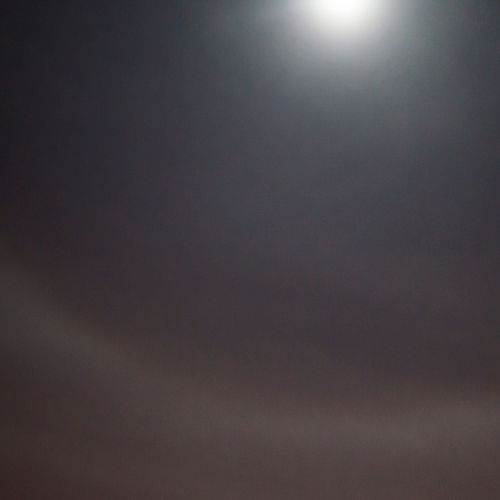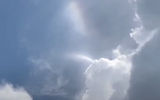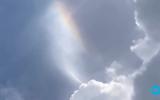| ID | #1705232201 |
| Added | Sun, 14/01/2024 |
| Author | July N. |
| Sources | |
| Phenomena | |
| Status | Result
|
| Resume |
Initial data
This phenomenon, so rare to observe, was captured in Texas. The clouds released a ray of light, creating a beautiful sight.
Hypotheses
Halo

Halo usually appears around the Sun or moon, sometimes around other powerful light sources such as street lights. There are many types of halos, but they are mostly caused by ice crystals in Cirrus clouds at a height of 5-10 km in the upper troposphere. The form of the observed halo depends on the shape and arrangement of crystals. Reflected and refracted by the ice crystals, the light often turns into a spectrum, which makes halo look like a rainbow, but a halo in low light has a low chroma, which is associated with the peculiarities of twilight vision.
Events
Rocket launches (from space.skyrocket.de)
- Site: () Vehicle: Falcon-9 v1.2 (Block 5) Payload: Starlink v1.5 G4-17-1 (Starlink 3870) Starlink v1.5 G4-17-2 (Starlink 3909) Starlink v1.5 G4-17-3 (Starlink 3872) Starlink v1.5 G4-17-4 (Starlink 3888) Starlink v1.5 G4-17-5 (Starlink 3890) Starlink v1.5 G4-17-6 (Starlink 3896) Starlink v1.5 G4-17-7 (Starlink 3899) Starlink v1.5 G4-17-8 (Starlink 3898) Starlink v1.5 G4-17-9 (Starlink 3856) Starlink v1.5 G4-17-10 (Starlink 3865) Starlink v1.5 G4-17-11 (Starlink 3900) Starlink v1.5 G4-17-12 (Starlink 3903) Starlink v1.5 G4-17-13 (Starlink 3885) Starlink v1.5 G4-17-14 (Starlink 3904) Starlink v1.5 G4-17-15 (Starlink 3863) Starlink v1.5 G4-17-16 (Starlink 3840) Starlink v1.5 G4-17-17 (Starlink 3873) Starlink v1.5 G4-17-18 (Starlink 3864) Starlink v1.5 G4-17-19 (Starlink 3828) Starlink v1.5 G4-17-20 (Starlink 3859) Starlink v1.5 G4-17-21 (Starlink 3862) Starlink v1.5 G4-17-22 (Starlink 3881) Starlink v1.5 G4-17-23 (Starlink 3879) Starlink v1.5 G4-17-24 (Starlink 3855) Starlink v1.5 G4-17-25 (Starlink 3882) Starlink v1.5 G4-17-26 (Starlink 3835) Starlink v1.5 G4-17-27 (Starlink 3860) Starlink v1.5 G4-17-28 (Starlink 3825) Starlink v1.5 G4-17-29 (Starlink 3878) Starlink v1.5 G4-17-30 (Starlink 3839) Starlink v1.5 G4-17-31 (Starlink 3842) Starlink v1.5 G4-17-32 (Starlink 3813) Starlink v1.5 G4-17-33 (Starlink 3875) Starlink v1.5 G4-17-34 (Starlink 3887) Starlink v1.5 G4-17-35 (Starlink 3913) Starlink v1.5 G4-17-36 (Starlink 3918) Starlink v1.5 G4-17-37 (Starlink 3902) Starlink v1.5 G4-17-38 (Starlink 3892) Starlink v1.5 G4-17-39 (Starlink 3923) Starlink v1.5 G4-17-40 (Starlink 3914) Starlink v1.5 G4-17-41 (Starlink 3908) Starlink v1.5 G4-17-42 (Starlink 3916) Starlink v1.5 G4-17-43 (Starlink 3883) Starlink v1.5 G4-17-44 (Starlink 3857) Starlink v1.5 G4-17-45 (Starlink 3905) Starlink v1.5 G4-17-46 (Starlink 3871) Starlink v1.5 G4-17-47 (Starlink 3884) Starlink v1.5 G4-17-48 (Starlink 3925) Starlink v1.5 G4-17-49 (Starlink 3894) Starlink v1.5 G4-17-50 (Starlink 3866) Starlink v1.5 G4-17-51 (Starlink 3907) Starlink v1.5 G4-17-52 (Starlink 3912) Starlink v1.5 G4-17-53 (Starlink 3861) Starlink v1.5 G4-17-1, ..., G47-53
Investigation
This is a phenomenon they callThe Crown flash. This is a rare optical effect caused by the alignment of ice crystals. Ice crystals are affected by electric fields around the cloud, and they reflect or refract sunlight in different directions. When the electric fields change due to lightning or other factors, the ice crystals also change their orientation, creating the appearance of flashing or dancing light.
Resume
Halo

Halo usually appears around the Sun or moon, sometimes around other powerful light sources such as street lights. There are many types of halos, but they are mostly caused by ice crystals in Cirrus clouds at a height of 5-10 km in the upper troposphere. The form of the observed halo depends on the shape and arrangement of crystals. Reflected and refracted by the ice crystals, the light often turns into a spectrum, which makes halo look like a rainbow, but a halo in low light has a low chroma, which is associated with the peculiarities of twilight vision.
Similar facts
Log in or register to post comments




